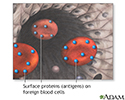Hemolytic transfusion reaction
Blood transfusion reaction; Transfusion reaction
A hemolytic transfusion reaction is a serious complication that can occur after a blood transfusion. The reaction occurs when the red blood cells that were given during the transfusion are destroyed by the person's immune system. When red blood cells are destroyed, the process is called hemolysis.
There are other types of transfusion reactions that do not cause hemolysis, such as febrile (causing fever) transfusion reactions.
Causes
Blood is classified into four different types: A, B, AB, and O.
Another way blood cells may be classified is by Rh factors. People who have Rh factors in their blood are called "Rh positive." People without these factors are called "Rh negative." Rh negative people form antibodies against Rh factor if they receive Rh positive blood.
There are also many other blood-related factors that differ among people, in addition to ABO and Rh.
Your immune system can usually tell its own blood cells from those of another person. If you receive blood that is even partially not compatible with your blood, your body produces antibodies to destroy the donor's blood cells. This process causes the transfusion reaction. Blood that you receive in a transfusion must be compatible with your own blood. This means that your body does not have antibodies against the blood you receive.
Most of the time, a blood transfusion between compatible groups (such as O+ to O+) does not cause a problem. However, minor mismatches in blood factors can cause a reaction. It is usually mild. Blood transfusions between incompatible groups (such as A+ to O-) cause an immune response. This can lead to a serious transfusion reaction. The immune system attacks the donated blood cells, destroying them.
Today, all blood is carefully screened. Transfusion reactions are rare.
Symptoms
Symptoms may include any of the following:
- Back pain
- Bloody urine
- Chills
- Fainting or dizziness
- Fever
- Flank pain
- Flushing of the skin
Symptoms of a hemolytic transfusion reaction most often appear during or right after the transfusion. Sometimes, they may develop after several days (delayed transfusion reaction).
Exams and Tests
This disease may change the results of these tests:
- Complete blood count (CBC)
- Coombs test, direct
- Coombs test, indirect
- Fibrin degradation products
- Haptoglobin
- Partial thromboplastin time (PTI)
- Prothrombin time (PT)
- Serum bilirubin
- Serum creatinine
- Serum hemoglobin
- Urinalysis
- Urine hemoglobin
Treatment
If symptoms occur during the transfusion, the transfusion must be stopped right away. Blood samples from the recipient (person getting the transfusion) and from the donor must be tested to tell whether symptoms are being caused by a transfusion reaction.
Mild symptoms may be treated with:
- Acetaminophen, a pain reliever to reduce fever and discomfort
- Fluids given through a vein (intravenous) and other medicines to treat or prevent kidney failure and shock
Outlook (Prognosis)
The outcome depends on how severe the reaction is. The disorder may run its course without problems. Or, it may be severe and life threatening.
Possible Complications
Complications may include:
- Acute kidney failure
- Anemia
- Lung problems
- Shock
When to Contact a Medical Professional
Tell your health care provider if you are having a blood transfusion and you have had a reaction before.
Prevention
Donated blood is put into ABO and Rh groups to reduce the risk for transfusion reaction.
Before a transfusion, recipient and donor blood are tested (cross-matched) to see if they are compatible. A small amount of donor blood is mixed with a small amount of recipient blood and tested to see if transfused cells are destroyed or clumped.
Before the transfusion, your provider will usually check again to make sure you are receiving the right blood.
References
Hall JE, Hall ME. Blood types; transfusion; and tissue and organ transplantation. In: Hall JE, Hall ME, eds. Guyton and Hall Textbook of Medical Physiology. 14th ed. Philadelphia, PA: Elsevier; 2021:chap 36.
Schipperus MR, Wiersum-Osselton JC. Transfusion reactions to blood and cell therapy products. In: Hoffman R, Benz EJ, Silberstein LE, et al, eds. Hematology: Basic Principles and Practice. 8th ed. Philadelphia, PA: Elsevier; 2023:chap 117.
Shaz BH, Hillyer CD. Transfusion medicine. In: Goldman L, Schafer AI, eds. Goldman-Cecil Medicine. 26th ed. Philadelphia, PA: Elsevier; 2020:chap 167.
Review Date: 2/2/2023
Reviewed By: Mark Levin, MD, Hematologist and Oncologist, Monsey, NY. Review provided by VeriMed Healthcare Network. Also reviewed by David C. Dugdale, MD, Medical Director, Brenda Conaway, Editorial Director, and the A.D.A.M. Editorial team.












